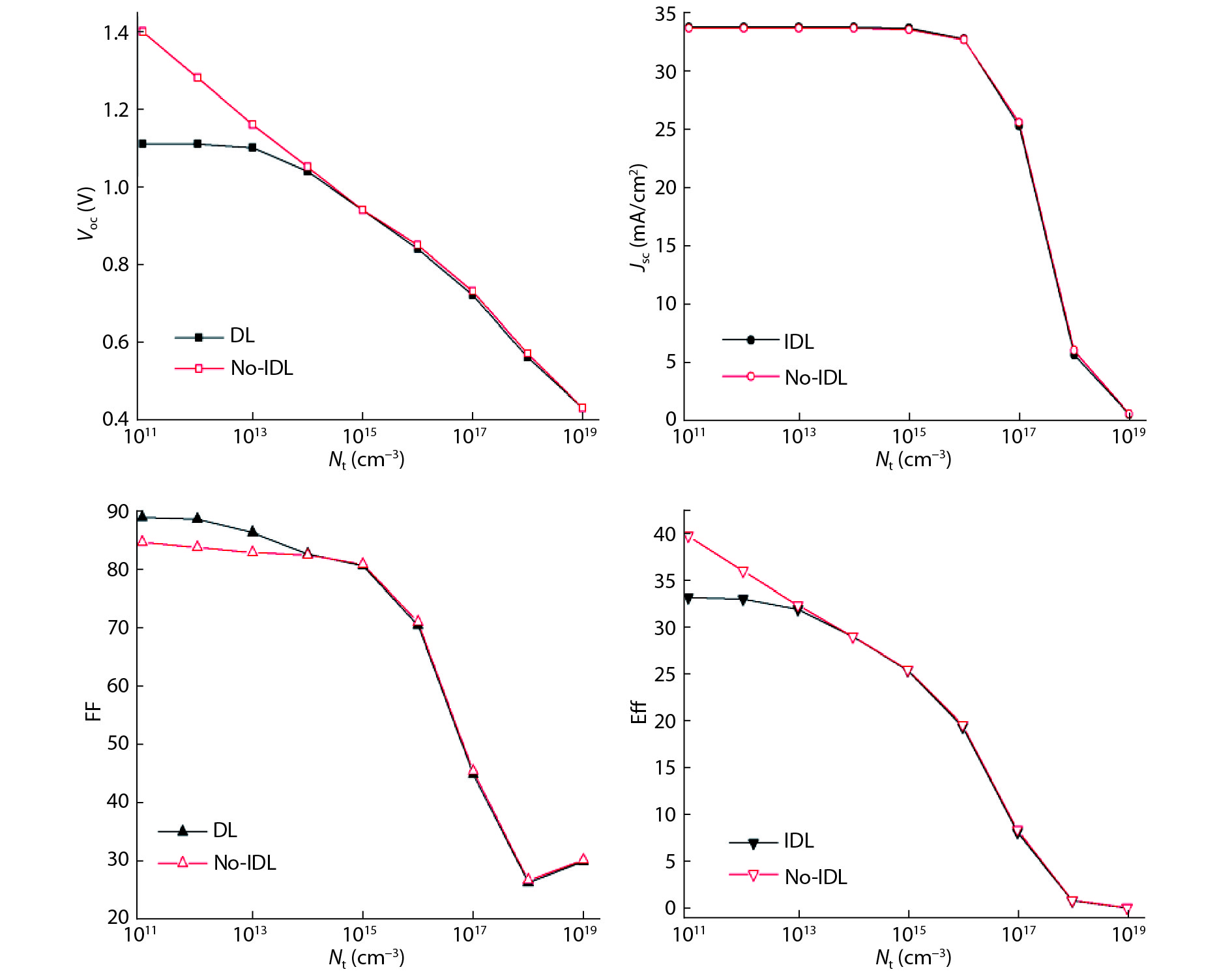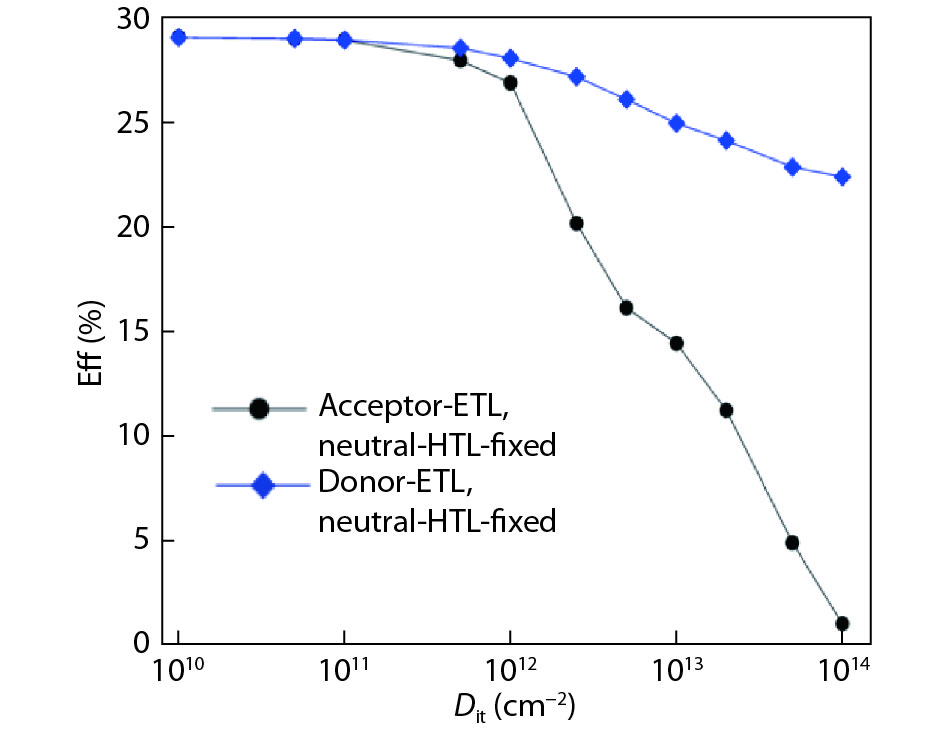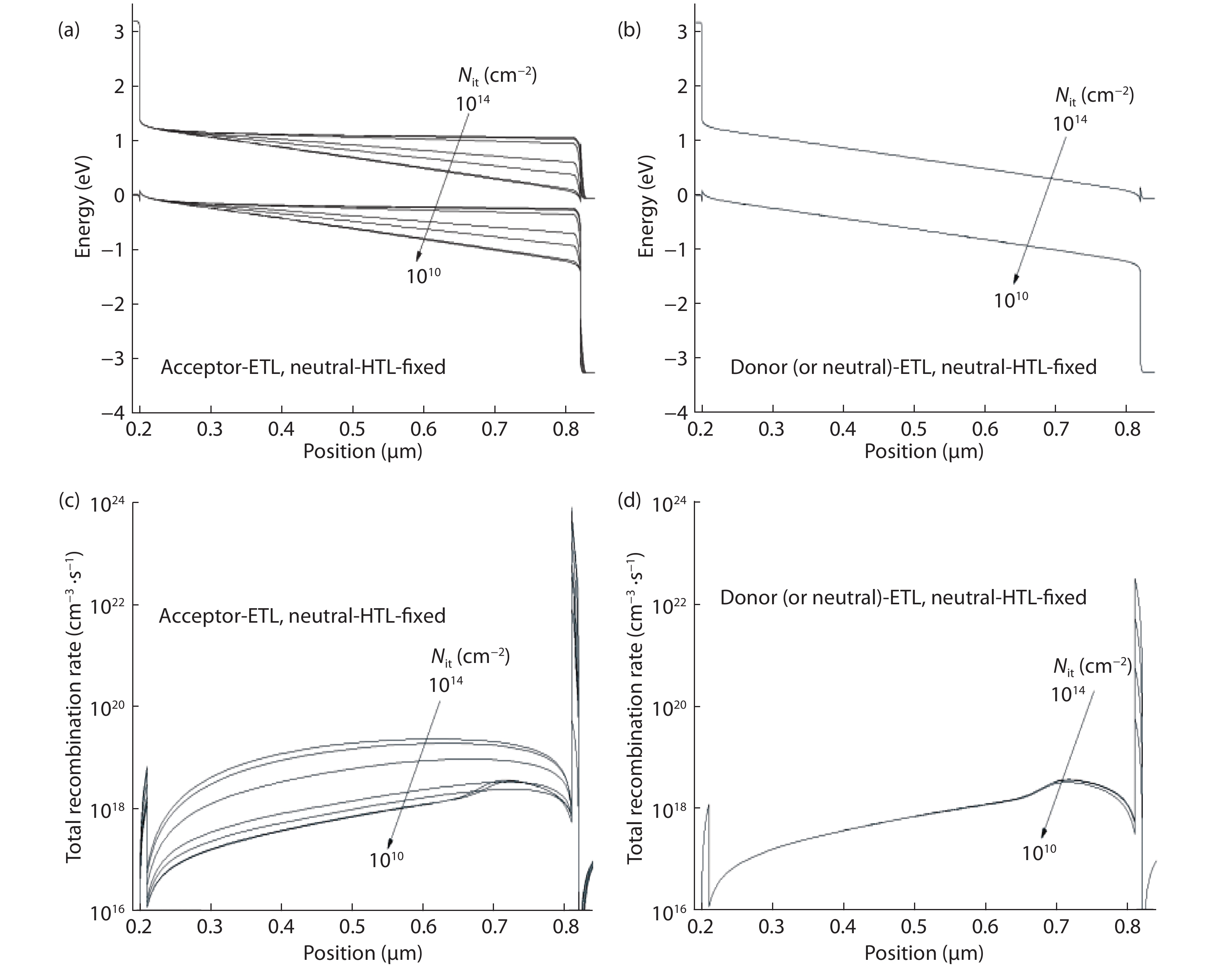| Citation: |
Shihua Huang, Zhe Rui, Dan Chi, Daxin Bao. Influence of defect states on the performances of planar tin halide perovskite solar cells[J]. Journal of Semiconductors, 2019, 40(3): 032201. doi: 10.1088/1674-4926/40/3/032201
****
S H Huang, Z Rui, D Chi, D X Bao, Influence of defect states on the performances of planar tin halide perovskite solar cells[J]. J. Semicond., 2019, 40(3): 032201. doi: 10.1088/1674-4926/40/3/032201.
|
Influence of defect states on the performances of planar tin halide perovskite solar cells
DOI: 10.1088/1674-4926/40/3/032201
More Information
-
Abstract
Although tin halide perovskite has shown excellent photoelectric performance, its efficiency of solar cell is low compared with that of lead halide. In order to enhance the efficiency of tin halide perovskite solar cell, a deep understanding of the role of the defects in the perovskite absorption layer and at the electron transport layer (ETL)/absorber or absorber/hole transport layer (HTL) interface is very necessary. In this work, the planar heterojunction-based CH3NH3SnI3 perovskite solar cells were simulated with the SCAPS-1D program. Simulation results revealed a great dependence of device efficiency on defect density and interface quality of the perovskite absorber. The defect density at the front interface is critical for high efficiency, and the polarity of the interface charge has a different impact on the device efficiency. Strikingly, an efficiency over 29% was obtained under the moderate simulation conditions. -
References
[1] Dou L, Yang Y M, You J, et al. Solution-processed hybrid perovskite photodetectors with high detectivity. Nat Commun, 2014, 5: 5404 doi: 10.1038/ncomms6404[2] Zhu H, Fu Y, Meng F, et al. Lead halide perovskite nanowire lasers with low lasing thresholds and high quality factors. Nat Mater 2015, 14: 636 doi: 10.1038/nmat4271[3] Stoumpos C C, Kanatzidis M G. The renaissance of halide perovskites and their evolution as emerging semiconductors. Acc Chem Res 2015, 48: 2791 doi: 10.1021/acs.accounts.5b00229[4] Stoumpos C C, Kanatzidis M G. Halide perovskites: poor man’s high-performance Semiconductors. Adv Mater, 2016, 28: 5778 doi: 10.1002/adma.201600265[5] Kojima A, Teshima K, Shirai Y, et al. Organometal halide perovskites as visible-light sensitizers for photovoltaic cells. J Am Chem Soc, 2009, 131: 6050 doi: 10.1021/ja809598r[6] Saliba M, Matsui T, Seo J Y, et al. Cesium-containing triple cation perovskite solar cells: improved stability, reproducibility and high efficiency. Energy Environ Sci, 2016, 9: 1989 doi: 10.1039/C5EE03874J[7] Green M A, Hishikawa Y, Warta W, et al. Solar cell efficiency tables (version 50). Prog Photovolt Res Appl 2017, 25: 668 doi: 10.1002/pip.2909[8] Hao F, Stoumpos C C, Guo P, et al. Solvent-mediated crystallization of CH3NH3SnI3 films for heterojunction depleted perovskite solar cells. J Am Chem Soc, 2015, 137: 11445 doi: 10.1021/jacs.5b06658[9] Yokoyama T, Cao D H, Stoumpos C C, et al. Overcoming short-circuit in lead-free CH3NH3SnI3 perovskite solar cells via kinetically controlled gas–solid reaction film fabrication process. J Phys Chem Lett, 2016, 7: 776 doi: 10.1021/acs.jpclett.6b00118[10] Handa T, Yamada T, Kubota H, et al. Photocarrier recombination and injection dynamics in long-term stable lead-free CH3NH3SnI3 perovskite thin films and solar cells. J Phys Chem C, 2017, 121: 16158 doi: 10.1021/acs.jpcc.7b06199[11] Noel N K, Stranks S D, Abate A, et al. Lead-free organic–inorganic tin halide perovskites for photovoltaic applications. Energy Environ Sci, 2014, 7: 3061 doi: 10.1039/C4EE01076K[12] Hao F, Stoumpos C C, Cao D H, et al. Lead-free solid-state organic–inorganic halide perovskite solar cells. Nat Photonics, 2014, 8: 489 doi: 10.1038/nphoton.2014.82[13] Zhao Z, Gu F, Li Y, et al. Mixed-organic-cation tin iodide for lead-free perovskite solar cells with an efficiency of 8.12%. Adv Sci, 2017, 4: 1700204 doi: 10.1002/advs.201700204[14] Gagliardi A, Maur M A, Gentilini D, et al. The real TiO2/HTM interface of solid-state dye solar cells: role of trapped states from a multiscale modelling perspective. Nanoscale 2015, 7: 1136 doi: 10.1039/C4NR05208K[15] Niemegeers A, Burgelman M. Numerical modelling of AC-characteristics of CdTe and CIS solar cells. 25th IEEE Photovoltaic Specialists Conference, Washington DC, 1996[16] Burgelman M. Modelling polycrystalline semiconductor solar cells. Thin Solid Films, 2000, 527: 361 doi: 10.1016/S0040-6090(99)00825-1[17] Zhou H, Chen Q, Li G, et al. Interface engineering of highly efficient perovskite solar cells. Science, 2014, 345: 542 doi: 10.1126/science.1254050[18] Edri E, Kirmayer S, Mukhopadhyay S, et al. Elucidating the charge carrier separation and working mechanism of CH3NH3PbI3-xClx perovskite solar cells. Nat Commun, 2014, 5: 3461 doi: 10.1038/ncomms4461[19] Minemoto T, Murata M, Device modeling of perovskite solar cells based on structural similarity with thin film inorganic semiconductor solar cells. J Appl Phys, 2014, 116: 054505 doi: 10.1063/1.4891982[20] Minemoto T, Murata M, Theoretical analysis on effect of band offsets in perovskite solar cells. Sol Energy Matter Sol Cells, 2015, 133: 8 doi: 10.1016/j.solmat.2014.10.036[21] Giorgi G, Yamashita K, Organic–inorganic halide perovskites: an ambipolar class of materials with enhanced photovoltaic performances. J Mater Chem A, 2015, 3: 8981 doi: 10.1039/C4TA05046K[22] Zhang Q, Dandeneau C S, Zhou X, et al. ZnO nanostructures for dye-sensitized solar cells. Adv Mater, 2009, 21: 4087 doi: 10.1002/adma.v21:41[23] Liu F, Zhu J, Wei J, et al. Numerical simulation: toward the design of high-efficiency planar perovskite solar cells. Appl Phys Lett, 2014, 104: 253508 doi: 10.1063/1.4885367[24] Hossain M I, Alharbi F H, Tabet N, Copper oxide as inorganic hole transport material for lead halide perovskite based solar cells. Sol Energy, 2015, 120: 370 doi: 10.1016/j.solener.2015.07.040[25] Umari P, Mosconi E, Angelis F D, Relativistic GW calculations on CH3NH3PbI3 and CH3NH3SnI3 perovskites for solar cell applications. Sci Report, 2014, 34: 4467 doi: 10.1038/srep04467[26] Khaliq A, Xue F L, Varahramyan K, Numerical simulation of spin coated P3HT organic thin film transistors with field dependent mobility and distributed contact resistance. Microelectron Eng, 2009, 86: 2312 doi: 10.1016/j.mee.2009.04.009[27] Chen A, Zhu K, Shao Q, et al. Understanding the effects of TCO work function on the performance of organic solar cells by numerical simulation. Semicond Sci Technol, 2016, 31: 065025 doi: 10.1088/0268-1242/31/6/065025[28] Toshniwal A, Jariwala A, Kheraj V, et al. Numerical simulation of tin based perovskite solar cell: effects of absorber parameters and hole transport materials. J Nano-Electron Phys, 2017, 9: 03038 doi: 10.21272/jnep.9(3).03038[29] Karimi E, Ghorashi S M B, Investigation of the influence of different hole-transporting materials on the performance of perovskite solar cells. Optik, 2017, 130: 650 doi: 10.1016/j.ijleo.2016.10.122[30] Nakanishi A, Takiguchi Y, Miyajima S, Device simulation of CH3NH3PbI3 perovskite/heterojunction crystalline silicon monolithic tandem solar cells using an n-type a-Si:H/p-type μc-Si1-xOx:H tunnel junction. Phys Status Solidi A, 2016, 213: 1997 doi: 10.1002/pssa.v213.7[31] Shockley W, Queisser H J, Detailed balance limit of efficiency of p-n junction solar cells. J Appl Phys, 1961, 32: 510 doi: 10.1063/1.1736034[32] Rühle S, Tabulated values of the Shockley-Queisser limit for single junction solar cells. Sol Energy, 2016, 130: 139 doi: 10.1016/j.solener.2016.02.015[33] Marti A, Araújo G L, Limiting efficiencies for photovoltaic energy conversion in multigap systems. Sol Energy Mater Sol Cells, 1996, 43: 203 doi: 10.1016/0927-0248(96)00015-3[34] Wehrenfennig C, Eperon G E, Johnston M B, et al. High charge carrier mobilities and lifetimes in organolead trihalide perovskites. Adv Mater, 2014, 26: 1584 doi: 10.1002/adma.201305172[35] Kontos A G, Kaltzoglou A, Siranidi E, et al. Structural stability, vibrational properties, and photoluminescence in CsSnI3 perovskite upon the addition of SnF2. Inorg Chem, 2017, 56: 84 doi: 10.1021/acs.inorgchem.6b02318[36] Yokoyama T, Song T B, Cao D H, et al. The origin of lower hole carrier concentration in methylammonium tin halide films grown by vapor-assisted solution process. ACS Energy Lett, 2017, 2: 22 doi: 10.1021/acsenergylett.6b00513[37] Ke W, Stoumpos C C, Logsdon J L, et al. TiO2-ZnS cascade electron transport layer for efficient formamidinium tin iodide perovskite solar cells. J Am Chem Soc 2016, 138: 14998 doi: 10.1021/jacs.6b08790[38] Xu X, Chueh C C, Yang Z, et al. Ascorbic acid as an effective antioxidant additive to enhance the efficiency and stability of Pb/Sn-based binary perovskite solar cells. Nano Energy, 2017, 34: 392 doi: 10.1016/j.nanoen.2017.02.040 -
Proportional views






 DownLoad:
DownLoad:

















